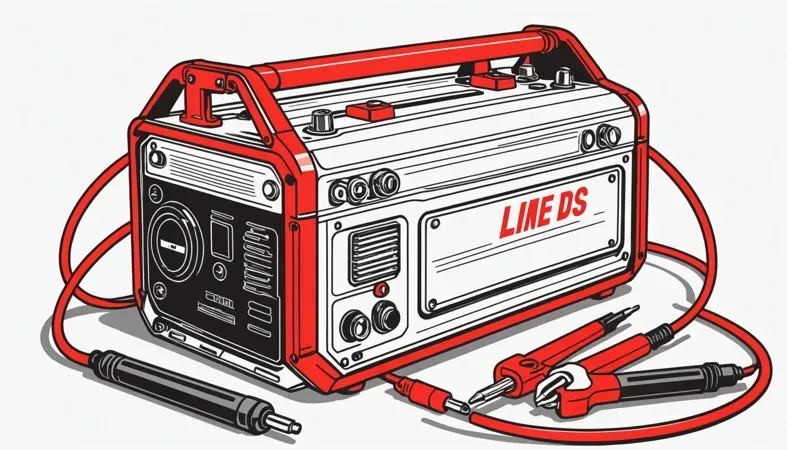How to Weld With a Car Battery? Essential Steps, Safety, and Tips
Published on: March 31, 2025 | Last modified: March 4, 2025
By: Tyler James
A car battery is a device that stores energy for starting a vehicle. It provides the electrical power needed to crank the engine and run electrical systems.
Many people are curious about how to weld with a car battery. It’s key to handle this topic carefully since mixing welding with car batteries can be risky. I’ve learned the hard way that proper knowledge and precautions can save you from mishaps, so let’s dig into it.
In this article, I’ll cover important aspects like types of car batteries, necessary prerequisites before welding, detailed steps for welding with a car battery, safety tips, factors affecting battery welding, common issues to watch for, and aftercare. You’ll also see the benefits of this technique and where it’s typically used. Plus, I’ll touch on related topics like how to weld batteries together and how to make a welder with batteries.
Contents
- How to Weld With A Car Battery?
- What is a Car Battery?
- Types Of Car Batteries
- Before You Start (Prerequisites)
- Steps to Weld With a Car Battery
- Safety Tips
- Types Of Welding With a Car Battery
- Factors Affecting Car Battery Welding
- Typical Problems to Be Aware Of
- Aftercare, Inspection, and Advanced Tips for Car Battery Welding
- How to Maintain Your Car Battery for Welding
- Benefits Of Welding With a Car Battery
- Where’s Car Battery Welding Used?
- Other Options You Can Consider
- Frequently Asked Questions (FAQs)
- Conclusion
- References
How to Weld With A Car Battery?
A car battery is a 12-volt energy source. To weld with a car battery, connect the negative clamp to your workpiece and the positive to the electrode. It’s tricky but great for small tasks like battery repairs and small metal projects.
What is a Car Battery?
A car battery is a rechargeable energy storage device used to start an engine and power electrical systems. Most car batteries are lead-acid types, containing six cells that produce 2.1 volts each, for a total of about 12.6 volts (V) when fully charged. Each cell holds an electrolyte solution of sulfuric acid and water, essential for the electrochemical reactions that generate electricity. In the U.
S., an average car battery has a capacity of around 48 amp-hours (Ah), providing enough energy for ignition and accessories.
Now, let’s discuss how to weld with a car battery. A typical 12V car battery can supply enough power to weld thin sheets of metal, which is both creative and resourceful. I tried this once and was surprised by its effectiveness—using jumper cables as leads was easier than I expected!
Welding with a car battery is fascinating. The process isn’t just about joining metal but also about innovation. I remember my first attempt: I needed to make battery tabs for a project. I connected my homemade welder to the battery, and it worked surprisingly well! This method shows how versatile electricity can be. So, don’t hesitate to experiment with different setups, but do so cautiously and with the right knowledge!
Types Of Car Batteries
So, what types of car batteries can you use for welding? Let’s dive in!
-
Lead-acid Batteries
These are the most common car batteries. To use a lead-acid battery effectively, connect your welder to the battery terminals. Attach jumper cables carefully to ensure strong, reliable power flow.
-
Lithium-ion Batteries
Lithium-ion batteries are lighter and more efficient. You can weld using these by connecting a suitable welder that matches their voltage, typically around 3.6V per cell.
-
AGM Batteries
Absorbent Glass Mat (AGM) batteries are spill-proof and last longer. To weld with AGM batteries, use a welder designed for their specific power output—usually 12V is optimal.
-
Gel Batteries
Gel batteries use silica gel to hold the electrolyte. You can weld using gel batteries by securely attaching a welder that matches their voltage specs at about 12V.
-
Maintenance-free Batteries
Maintenance-free batteries require no watering. To weld with these, ensure your contact points are clean for effective power transfer at about 12V to 13.5V.
We covered the different types of car batteries here. Next, we will cover what you need to know before starting.
Before You Start (Prerequisites)
What do you need to get started?
- Car Battery: You’ll need a 12V (Volt) lead-acid battery from brands like Optima or Interstate. It supplies the current for welding.
- Welding Cables: Grab thick welding cables, like 4 AWG (American Wire Gauge). They efficiently carry high current from the battery.
- Electrode Holder: You need an electrode holder, such as the Lincoln Electric KH521, to securely hold your welding rod. It’s essential for effective welding.
- Welding Rods: Use low-carbon steel rods, like 6011 or 7018, sized 3.2mm (1/8 Inch), for strong joints. The right rods ensure better fusion.
- Jumper Cables: Get heavy-duty jumper cables, like Energizer’s 4-gauge. They connect your battery to the welding system safely and provide high conductivity.
You should now have a good understanding of prerequisites before you start welding. In the next part, we’ll discuss the steps to weld with a car battery.
Steps to Weld With a Car Battery
Now, let’s cover steps to weld using a 12V car battery effectively. Follow these steps for successful welding!
-
Connect Jumper Cables
First, grab your jumper cables. Attach the red cable to the positive terminal of the battery and the other end to the workpiece. Then, connect the black cable to the negative terminal and attach it to the ground of your welding setup. Ensure tight connections to avoid voltage drops—any drop can reduce welding effectiveness. Mastering these steps is crucial for precise results, especially when learning to weld 45-degree angles.
Keep an eye on the cable gauge. For welding, use at least 8-gauge cables, as they can carry higher currents for a stronger weld. I once made the mistake of using thinner cables, which melted away!
Knowing how to manage cables is crucial especially when working with different thicknesses of metal, such as 16-gauge sheet metal welding techniques.
-
Ensure Proper Settings
Next, set the appropriate voltage and amperage for your welding operation. A standard 12V battery can output around 300-600 amps momentarily. This is crucial for achieving the right heat during welding. If you’re working with thinner metals, adjust your position to prevent burning through.
Set your welding parameters manually if possible. This helps control the weld pool better. If you notice excessive spatter or weak joints, check your settings again. A small adjustment can lead to significant improvement!
Choosing the right electrode classification is crucial for weld quality and precision, and you can learn more about the properties of the E316-16 electrode to enhance your knowledge.
-
Position the Electrode
Take your welding rod or electrode and position it at roughly 45 degrees to the work surface. Adjust your grip to control your space and travel speed. The tip of the electrode should touch the workpiece briefly before you lift it to start the arc. This initial contact helps establish an arc, ensuring strong penetration.
Hold the welding rod steady while moving it smoothly along the weld joint. Varying the speed can significantly change heat distribution in the material. Move too fast, and you risk a weak bond; move too slow, and you’ll burn holes. Find a rhythm that works for you. For further understanding of different welding positions, explore the nuances of 1f 2f 3f 4f welding.
-
Control the Weld Pool
While welding, controlling the weld pool is vital. Watch the molten metal closely; a small puddle indicates you’re on the right track. Move the rod at a steady pace, keeping the weld pool fluid and manageable. A weld pool that’s too large can lead to weak joints.
Changing the angle of the electrode can help maintain better control over the weld pool. Aim for balance between speed and weld quality. Remember, practice makes perfect—experiment with different techniques to see which yields the best results!
We covered steps for welding with a car battery here. Next, we will cover safety precautions to consider.

Safety Tips
Let’s cover some essential precautions while welding with a car battery.
- Wear Protective Gear: Always use gloves, goggles, and a welding helmet, like Lincoln Electric’s K2977-1.
- Avoid Flammable Material: Keep combustibles at least 10 feet (3 Meters) away from your workspace to reduce fire hazards.
- Check Connections: Secure all clamps to prevent sparks; I recommend copper clamps for reliable connections.
- Stay Hydrated: Drink water to stay focused; heat can lead to dehydration and impaired judgment.
Staying safe is key to your success—I care about your safety!
We’ve wrapped up safety precautions and essential tips here. Next up, we’ll look at various welding techniques using a car battery.
Types Of Welding With a Car Battery
Let’s cover the types of welding you can do with a car battery: Stick Welding, TIG Welding, Arc Welding, Multi-Process Welding, and Portable Welding.
-
Stick Welding
Stick welding, or Shielded Metal Arc Welding (SMAW), uses a flux-coated electrode. A typical car battery provides about 12 volts, enough to create an electric arc. This method is simple and portable, making it a good choice for quick repairs.
-
TIG Welding
TIG welding, or Gas Tungsten Arc Welding (GTAW), often requires more complex equipment than just a battery. However, some have wired a 12-volt battery to build custom TIG welders. It produces clean, precise welds, ideal for thin materials like battery tabs.
-
Arc Welding
Arc welding uses an electric arc to melt metal. A car battery can generate enough heat for this. It’s versatile and useful for various applications but may need additional parts for optimal results.
-
Multi-process Welding
Multi-process welding allows you to use different techniques with one machine. Typically, you’ll need a more powerful setup, but some have creatively adapted batteries for small projects. It provides flexibility for users.
-
Portable Welding
Portable welding focuses on convenience. Using a car battery makes it possible! You can weld wherever you can park, making it perfect for on-site repairs.
Factors Affecting Car Battery Welding
What factors influence the effectiveness of welding with a car battery?
-
Battery Voltage
A typical car battery provides 12 volts (V). Higher voltage increases weld penetration and speed, but excessive voltage can damage workpieces.
-
Welding Rod Type
The choice of welding rod is crucial. For a car battery, use low-voltage rods like 6013. They optimize heat and ensure good fusion.
-
Workpiece Material
I recommend using steel or mild steel. Aluminum can cause issues like overheating, making welding more difficult. Different materials can affect the welding process.
-
Ambient Temperature
Welding in cold conditions can slow your process. Optimal temperatures are around 21°C (70°F) for consistent results. Too warm can lead to warping.
-
Connection Quality
Clean, tight connections enhance performance. Use proper welding leads to minimize resistance. Poor connections decrease current flow and significantly affect weld quality.
Typical Problems to Be Aware Of
Let’s look at unique issues with car batteries.
-
Overheating
Car batteries can overheat, reducing efficiency. Check for swelling or a hot casing. If found, cool it down slowly and check connections for tightness.
-
Inadequate Power Supply
Your car battery might not provide enough power. Test the voltage; if it’s below 12.4V (74% State Of Charge), recharge promptly. I recommend using a quality charger to maintain battery health.
-
Poor Weld Quality
Using a car battery for welding can lead to weak joints. Inspect welds for consistency and ensure correct heat settings for the best results.
-
Battery Damage From Excessive Use
Frequent high-drain activities can damage the battery. Monitor usage and recharge when voltage dips below 12.0V (25% State Of Charge) for optimal longevity.
-
Short-circuiting Risks
Car batteries pose a risk of short-circuiting. Look for exposed terminals and frayed cables. Always secure connections and use covers to prevent accidental contact.
Aftercare, Inspection, and Advanced Tips for Car Battery Welding
Here’s important information on aftercare, inspection, and advanced tips for effective battery welding.
Aftercare Tips
After welding with a car battery, promptly disconnect the battery. Check for any joint heat to avoid burns. Let joints cool for 10 to 15 minutes before handling. If you’re using a dedicated setup, clean the clamps with isopropyl alcohol to ensure a clean electrical connection next time.
Inspection
Begin by ensuring your battery terminals, especially if you’re using Deka or Optima brands, are free of corrosion. Check cables for frays; use a millimeter dial gauge (0.1 Mm) to measure thickness. Finally, ensure your welding rods match the thickness specified by the manufacturer for consistency and safety.
Expert Tips
Adjust voltage settings between 12V and 13.5V (Around 144W) for stronger welds. Use 0.8 mm to 1 mm tungsten rods for enhanced joint cohesion. Aim for a clean puddle, and monitor heat distribution using thermocouples to maintain optimal temperatures around 400°C (752°F) during the process.
How to Maintain Your Car Battery for Welding
Keeping your car battery in good shape can significantly improve your welding experience. Here are some essential maintenance practices.
Regular Inspections
- Check for corrosion on terminals. Clean with a mixture of baking soda and water.
- Inspect cables for fraying or damage. Replace as necessary.
- Measure the voltage using a multimeter. Ideally, it should read 12.6V (100% state of charge).
Battery Health Check
Use these parameters to monitor your battery’s health:
| Parameter | Optimal Value | Action Required |
|---|---|---|
| Voltage | 12.6V (100%) | Recharge if below 12.4V |
| State of Charge | 75% or higher | Recharge regularly |
| Electrolyte Level | Above the plates | Add distilled water if low |
Proper Storage
Store your battery in a cool, dry place to prevent sulfation—a common battery problem. Ensure temperature stays between 5°C to 25°C (41°F to 77°F).
Regular Charging
Charge your battery after heavy use to maintain capacity. A battery charger can help keep it topped up, especially if it’s been used for welding tasks frequently.
Benefits Of Welding With a Car Battery
The main advantage of using a car battery for welding is its accessibility. You likely have one available, making it a cost-effective solution for small welding tasks.
Additionally, welding with a car battery can be surprisingly efficient. It’s portable, allows for quick setups, and can be used in locations without standard power sources. You’ll appreciate the flexibility and ease of using a simple 12V (Volt) battery.
Where’s Car Battery Welding Used?
People often use car battery welding for quick fixes, but it has many applications, such as:
- Automotive Repairs: Car battery welding is popular for repairing body panels or fixing loose connections. It’s quick and handy when traditional welding methods aren’t feasible.
- Bike Frames: Cyclists often use battery welding to repair aluminum bike frames. This method offers a lightweight and portable solution for broken frames.
- Battery Tab Welding: In the battery industry, welding tabs to battery cells ensures strong connections, which is essential for creating reliable battery packs for electronics.
- Small Metal Fabrication: Hobbyists use car battery welding for small projects, like creating art or custom tools. Its simplicity allows for quick prototyping with low-cost equipment.

Other Options You Can Consider
There are plenty of alternatives you can try if the car battery method isn’t for you. For instance, a Transformer Welder, like the Everlast PowerMTS, offers a stable weld and often delivers better results in tougher jobs. From what I’ve encountered personally, a Car Battery Welding Kit gives you a portable option, and it’s easier to handle for smaller projects.
Jumper cables can also work well, but a quality set will make a big difference. You might also look into weld battery chargers, which create a solid current and can improve your welding experience. Can you believe how versatile these tools can be? Each option has its perks, so choose what fits your project best!
Frequently Asked Questions (FAQs)
Now let us look at some of the questions I typically get asked.
Do You Need to Disconnect the Car Battery When Welding?
Yes, you need to disconnect the car battery when welding. Welding generates high heat and electric currents that can damage the battery and other electronics. Disconnecting it helps prevent short circuits and electrical failures, protecting your vehicle’s components.
Can You Weld on a Truck With the Battery Connected?
No, you can’t weld on a truck with the battery connected. Leaving it connected while welding risks damaging electrical systems or even causing battery explosions due to the heat. It’s safer to disconnect the battery before beginning any welding work.
How to Weld Battery Tabs?
You can weld battery tabs using spot welding methods or dedicated battery welders. These tools apply intense heat in a short burst, fusing the tabs without damaging the battery cells themselves. This method ensures a strong connection that’s crucial for battery performance.
Can You Weld a Battery Terminal?
Yes, you can weld a battery terminal, but it requires care. High temperatures can melt plastic parts or harm internal components. Make sure to use a low heat setting and keep the weld short to minimize potential damage.
How to Weld Batteries Together?
You can weld batteries together using a spot welder. This device creates a quick and powerful heat that melts metal parts, affecting only the area being welded. It’s essential for maintaining battery integrity and ensuring stable connections.
How to Make a Welder With Batteries?
You can make a welder with batteries by using a DC current setup with components like an inverter or transformer. Consider voltage and amperage significant for the job. A standard car battery (12V) can effectively function if built correctly, giving you a portable welding solution.
Conclusion
You made it to the end. We covered how to weld with a car battery, what a car battery is, types of car batteries, prerequisites before starting, steps for welding, necessary safety tips, types of welding methods, factors affecting welding, typical challenges, aftercare, inspection, advanced tips, benefits, applications, and alternatives. That’s quite a bit of ground we covered.
In simple terms, welding with a car battery is all about using the battery’s output to fuse materials together. First, gather your gear, then connect the battery carefully, set up your workspace, and get to welding. Wishing you success in your welding projects, and remember, practice makes perfect when learning how to weld with a car battery.
For those eager to deepen their understanding of welding techniques and principles, feel free to visit What is Welding for more insights.
References
- Canadian Welding Bureau (CWB): https://www.cwbgroup.org
Tyler is a passionate DIY welder and self-taught metal artist with years of hands-on experience transforming raw materials into functional and artistic creations. Specializing in MIG welding, Tyler crafts everything from custom furniture to outdoor sculptures, blending creativity with technical skill. Committed to making welding accessible, Tyler shares practical insights and project inspiration to help beginners and hobbyists confidently explore the world of metalworking.
Car Battery, DIY Welding, Metal Fabrication, Safety Tips, Voltage Drop, Welding, Welding Equipment, Welding Techniques, Wire Gauge







